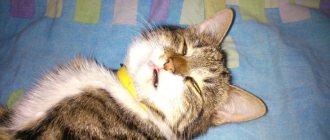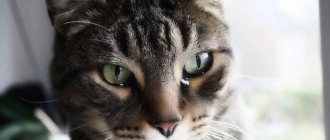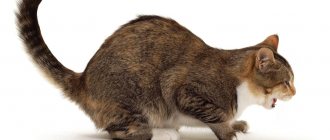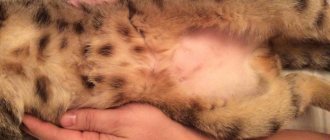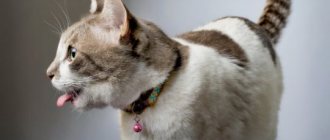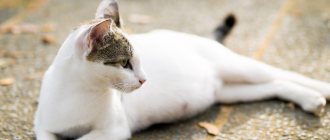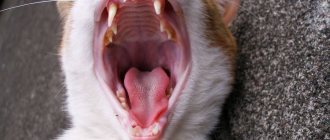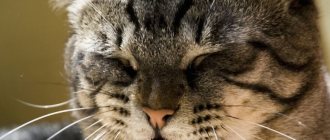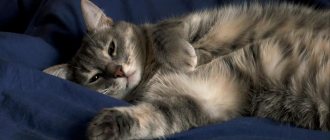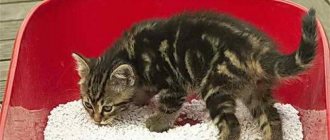Why is the cat snoring?
The respiratory system of cats is similar to humans.
Our pets can sigh, sniffle and even snore in the same way. Most often this happens in a dream. Dreams of cats can consist of various events that cause an external reaction not only in the form of twitching their paws, as if the animal is running, shuddering, but also reactions of the respiratory system. But if a cat or kitten sniffles not only during sleep, but also when awake, this may indicate the appearance of health problems. In this case, the owners need to more carefully observe the pet, which sniffles when it breathes, and track the duration and frequency of the snoring. This can help in determining the cause of the condition, and in deciding what to do and how to treat the animal.
Periodic snoring is normal for humans and animals. If this happens rarely, it should not be a cause for concern. But if it's a cat sniffling while breathing all the time, or even breathing with its mouth open, it should be a cause for concern. Persistent breathing problems can lead to more serious health problems.
Most likely, you will need a veterinarian's consultation and treatment, because... It is difficult or even impossible to independently determine the disease. But before contacting a doctor, it is necessary to observe an animal that is sniffling and breathing heavily. To make a diagnosis, exclude various diseases and prescribe the correct treatment, the doctor will need detailed information.
The veterinarian may ask for the following information about a cat who wheezes when he breathes:
- the age of the animal and its lifestyle;
- weight and its relationship with the norm for a given breed;
- how long ago did the wheezing occur?
- Are there other sounds heard when the cat breathes?
- changes in the color of mucous membranes;
- the presence of various injuries (torso, nose, mouth, larynx);
- changes in behavior (low activity, weakness, excitability);
- other symptoms (digestive problems, vomiting, other breathing problems, cough, runny nose, sneezing).
If your cat is breathing poorly through his nose and sniffling, you should not wait for this to go away on its own. Such signs may indicate a serious illness in a cat or kitten that requires immediate treatment.
By the nature of the snoring and sounds, you can often roughly determine the source of the disease:
- wet rales indicate the presence of phlegm in the respiratory organs;
- dry wheezing indicates the presence of swelling in the bronchi or throat;
- crackling – there may be problems in the alveoli;
- A whistling sound may indicate swelling in the respiratory tract.
Only timely initiation of treatment and the correct choice of medications can ensure a quick and complete recovery of the pet. You should not rely on the recommendations of other cat owners from forums - each case is individual, even with similar symptoms.
Many owners contact the editors of the MURKOTIKI website with a question about why their Scottish cat snores in his sleep. We answer what the reasons may be. These same points will be the answer to the question why a British cat (cat) snores or wheezes, because... These two breeds are similar.
The respiratory system of cats is similar in structure to that of humans. They, just like humans, can sigh, grunt and even snore. If a cat sniffles not only in his sleep, this may be a symptom of an illness.
The animal begins to sniffle as a result of inflammation of the nasopharyngeal mucosa. This happens due to hypothermia or a cold.
A pet's runny nose often occurs as a result of exposure to chemicals. Rhinitis can be a consequence of any past illness.
If a cat sniffles, you need to monitor it; the sick pet constantly rubs its nose with its paws, often sneezes, and has difficulty breathing.
In addition, the pet looks apathetic, there is exhaustion, and the development of conjunctivitis.
In case of a cold or rhinitis, treatment must be carried out to avoid negative consequences.
Weak or rapid breathing in a cat signals changes occurring in the pet’s body. Deviation from the norm is not always a pathology. But the owner must be able to recognize a dangerous symptom in order to provide timely help to the pet. How do cats breathe and what do these or other changes in breathing indicate?
There are many situations when rapid breathing in a cat is not a pathology. For example, from fear, rage, surprise, or at a moment of joyful excitement, a cat breathes faster. This is a momentary change; breathing returns to normal after a short period of time, usually after the cat has stopped exposing the cat to external stimuli.
Shallow, rapid breathing in a cat during a trip, in the veterinarian’s office, or during an unpleasant manipulation is a conditional norm, signaling that the pet is experiencing stress. Pregnant, giving birth, nursing pets and cats in heat also breathe somewhat faster. The breathing rate in cats changes depending on the degree of stress: during sleep the rate is lower, during active games it is higher.
Not only people, but also beloved cats are susceptible to nasal congestion. A runny nose occurs quite often in cats. This is due to the fact that the nasal passages of pets are very small, and the slightest inflammation or irritation causes severe congestion. What to do if your animal has a stuffy nose? You will learn how to help a cat with a runny nose in this article.
Helminthiasis
Extensive parasite infestation may explain why the cat grunts. Some types of worms develop in the lungs. By feeding on blood, tissues and multiplying in the respiratory tract, helminths provoke the occurrence of an inflammatory process and the formation of pathogenic microflora. As a result, the cat develops breathing problems accompanied by grunting.
In advanced stages, grunting and coughing result in vomiting, in which live parasites can be found. Treatment of pets with anthelmintic drugs should be carried out not only for therapeutic, but also for preventive purposes.
Variant of the norm
If your feline pet sniffles, but does not express any pain, his behavior has not changed, he plays, eats well, you need to examine the animal:
- if the nasal mucosa is pink, then the body receives enough oxygen;
- there is no discharge from the nose, which means a cold is excluded;
- Light pressure over the entire back will help determine whether there are or are no areas of pain.
Breathing with wheezing may be caused by a deviated nasal septum or obesity, which is not life-threatening.
When your cat sniffles, she also scratches her nose with her paws and sneezes; perhaps she just has an allergy, which will disappear after the allergen is eliminated.
The fact that a Scottish cat wheezes or snores does not mean pathology. This may be a variant of the norm, as in British cats. The fact is that they belong to the flat-faced breeds, whose head, no matter how you look at it, resembles a ball. That is, the nose of a Scottish and British cat is flattened, and the internal passages are slightly narrowed. It is because of this that in a dream there can be snoring and glanding - from quiet to moderate. This is what it sounds like.
So the first answer to the question of why a fold-eared cat or a straight-eared cat snores will be a breed feature. When you hear this, there is no need to panic. However, if necessary, it is still worth checking with a veterinarian, and here’s why.
Possible causes and most common diseases
You need to understand that in some breeds (brachycephalics), sniffing during sleep is considered absolutely normal due to the structural features of the muzzle. The only thing is that it is more difficult for them to recognize the symptoms of respiratory pathologies in time. In all other cats, such symptoms can be caused by the following reasons:
Foreign body. It's not often that something gets into a cat's nose, but even a small piece of fabric or thick paper can cause snoring and whistling when breathing. Almost always, owners manage to remove the source of irritation on their own. In rare cases (splinters, plant thorns), the participation of a surgeon is required.- Allergy. It has a huge number of varieties, but we are interested in contact dermatitis, which is characterized by the appearance of crusts in the nose that can cause wheezing when breathing. Food allergies usually include watery eyes, sneezing, swelling of the face, and various types of rashes. Contact dermatitis is characterized by nasal congestion and discharge, sneezing and itching. This reaction can be triggered by home flowers, household chemicals, or pollen from flowering plants (in pets with access to the street). Unfortunately, allergies are very difficult
Diagnosis and even more difficult to treat, so very often you have to resort to the method of excluding potential allergens. In some cases, the reason may even lie in the tray filler, after replacing which all symptoms gradually fade away. It is also recommended to limit animals’ access to household chemicals and detergents. - Growths. The most common formations found in the nose of cats are polyps. Their danger lies in the fact that they can cause overgrowth of the nasal passages, which will inevitably affect the general condition of the pet. At first, you may notice a slight sniffling through your nose during sleep or at rest. In the future, nasal discharge and an unpleasant odor may appear. The diagnosis can be confirmed using x-rays and rhinoscopy. In severe cases, an MRI of the entire head may be needed. The need for removal is determined only by the surgeon. Ideally,
polyps of any size should be removed and sent for histological examination. - Tumors. Most often malignant. Occurs in adults after 10 years. They are usually detected in the later stages, since the symptoms are very similar to many viral infections. At the initial stage, you may notice that the cat is sniffling through its nose. Subsequently, discharge and a foul odor appear. In severe cases, serious breathing problems begin, the nose bleeds, and the general condition rapidly deteriorates. With tumors everything is much more complicated (unlike polyps). For diagnosis, it is necessary to do a rhinoscopy, biopsy, MRI and CT scan of the head. X-rays are also indicated to exclude metastasis. Removal is only surgical with the capture of healthy tissue. In most cases, the prognosis is unfavorable due to
late detection and age of the animal. - Cat flu. Recently, it has become increasingly common even in young, vaccinated individuals. You can become infected from a sick cat or other animal carrier. The danger is that the mortality statistics are very high. But this is in the absence of treatment. At the initial stage, the disease affects the nasopharynx, which affects breathing - wheezing, whistling and gurgling appear. As the process progresses, pus begins to discharge from the nose. In advanced cases, the body temperature rises and the lungs are involved in the process. Treatment is strictly individual with the use of potent antibiotics. Much attention is paid to prevention, which includes disinfection of housing and all objects with which the sick animal has been in contact.
What can be the consequences of rhinitis?
Cats with respiratory problems should have free access to water. And you should receive more water than usual, unless the veterinarian prescribes otherwise. If it is possible to humidify the air, it is worth doing so. This procedure will help the secretion drain.
In case of respiratory failure, foreign bodies, or asthma, you cannot force the animal to drink. If there is respiratory failure, your veterinarian may remove excess fluid from the lungs. In some cases, surgery may be required.
Antitussive treatment should be prescribed by a doctor.
In the case of an infectious disease, the cat needs specific treatment. You should not give your animal vodka.
If foamy and bloody discharge appears from the nose, the cat should be taken to the hospital as soon as possible.
Without timely help, the animal may die.
Pets, particularly cats, are susceptible to many infectious diseases; they can catch colds due to a draft or resting on a cold floor. Diseases can be infectious or respiratory. If a cat sniffles through its nose, the reasons may be related specifically to the disease, the onset of an inflammatory process in the mucous membrane.
Rhinitis, rhinotracheitis, and the presence of feline herpes can be diagnosed by a veterinarian. He will tell you how to clean a cat’s nose to make breathing easier, and he will tell you how to treat the disease.
If a runny nose accompanies nasal congestion, chronic sluggish rhinitis is most likely due to a decrease in immune potential.
If a cat does not breathe through its nose, it may have a severe allergy to hot steam, household chemicals, pollen, and chemicals. Allergic reactions are typical for purebred cats, but they can be an individual feature of even a domestic animal. At the same time, the cat may have noticeable discharge, like a runny nose, the pet sneezes and snorts.
We invite you to read: Epilepsy in cats: forms, symptoms, treatment
A runny nose and inflammation of the mucous membranes should be treated promptly; there is no need to wait for complications for the pet to become deaf or for the inflammation to spread to other respiratory organs.
- If rhinitis occurs due to an infection, bacterial or viral, the veterinarian prescribes antibiotics and antibacterial drugs, taking into account the animal’s age and breed. It is important to strictly adhere to the instructions and carry out the course of treatment to the end, even if there is no discharge and the nose can breathe freely.
- The course of treatment for rhinitis may include antipyretic, anti-inflammatory, and sedative drugs.
- Sometimes the veterinarian recommends rinsing the animal’s nose to ease its breathing and general condition.
- Inhalations with essential oils are effective for rhinitis; you just need to strictly follow the dosage of oil drops. The nose is also warmed up with warm sand or salt wrapped in a clean cloth.
- If your pet has dry skin around its nose, you can constantly moisturize it with baby cream or Vaseline.
If you need to clear your nose, you should act very carefully and carefully, following the advice of experts. Wounds can not only cause pain, but also become a source of infection. You can clean the crusts with a damp cotton swab.
An irresponsible cat owner can rely on a miracle and wait for the pet’s runny nose to go away on its own. But congestion and discharge, inflammation associated with colds or allergies, need to be treated and only as prescribed by a doctor.
If an animal does not breathe well, it does not receive the required amount of oxygen. Because of this, appetite and general condition worsen, and the body becomes exhausted. Acute rhinitis, with inactivity, becomes chronic, and it is much more difficult to treat.
If your cat's runny nose is caused by hypothermia, you need to provide her with warmth and rest.
If you do not know the exact cause of your pet's rhinitis, then the best option would be to consult a specialist. The veterinarian will determine the cause of the animal’s runny nose and draw up a comprehensive treatment plan using various medications.
A runny nose can develop into purulent rhinitis
Because of this, the functioning of all organs of the animal may deteriorate. After this, the pet will become passive, the appetite will worsen and the entire body will be exhausted. If acute rhinitis in a pet is not treated, it can develop into chronic rhinitis, which requires long-term treatment and increased care.
Treatment
Cats with respiratory problems should have free access to water. And you should receive more water than usual, unless the veterinarian prescribes otherwise. If it is possible to humidify the air, it is worth doing so. This procedure will help the secretion drain.
In case of respiratory failure, foreign bodies, or asthma, you cannot force the animal to drink. If there is respiratory failure, your veterinarian may remove excess fluid from the lungs. In some cases, surgery may be required.
Antitussive treatment should be prescribed by a doctor.
In the case of an infectious disease, the cat needs specific treatment. You should not give your animal vodka.
If foamy and bloody discharge appears from the nose, the cat should be taken to the hospital as soon as possible.
Without timely help, the animal may die.
Brachycephalic cat breeds: when shortness of breath is a consequence of illness
In some cat breeds, shortness of breath is very common. These are breeds with skulls affected by brachycephaly.
Brachycephaly is a genetic disorder that causes difficulty breathing, snoring, snoring, snoring, and other related conditions such as watery eyes. Brachycephalic cat breeds are artificially bred, and many owners believe that the flattened face is an attractive feature, despite the negative health consequences.
There are 5 common breeds of flat-faced cats:
- Persian cat;
- exotic cat;
- Scottish;
- British Shorthair;
- manul
All the negative components of brachycephalic syndrome are aggravated by stress, obesity, respiratory infections, physical activity and overheating. Therefore, it is extremely important to protect the animal from these factors whenever possible.
Due to the structural features of the trachea and larynx, such cats develop respiratory failure and, as a result, fainting. All breeds with a shortened muzzle require increased attention from the owner, regular examinations and constant monitoring by a veterinarian.
Severe snoring (glanders) and a number of accompanying pathological features that seriously impede breathing are called brachycephalic syndrome. This syndrome is typical for cats with small noses and round heads: Persians, Exotics, British and Scottish.
Brachycephalic syndrome can be eliminated surgically, which, however, is not always considered justified. However, there are such manifestations when, due to this syndrome, the cat has cyanosis of the mucous membranes, the airways swell, the load on the heart increases, and after the slightest overheating or physical activity, convulsions develop or the cat loses consciousness. This condition significantly impairs the quality of life and can be fatal, and therefore requires treatment. .
Pathological causes of snoring
Infectious diseases of the respiratory organs
Why does a cat snore in his sleep? This can also be caused by pathological reasons. Snoring can often be caused by infectious diseases of the respiratory organs: bronchitis, pneumonia, pneumonia. A cat can become hypothermic if it has been in the cold for a long time, slept under a powerful air conditioner, sat in a draft, and become ill.
Dry air, especially in winter, during the heating season, dries out the nasopharyngeal mucosa of a pet. Viruses and bacteria easily enter the body because local immunity cannot cope with them. A runny nose begins - mucus forms in the nose, clogging the nasal passages, so air passes through with difficulty and with a characteristic sound. Other symptoms of a respiratory infection: coughing, sneezing, blue gums. Wheezing when inhaling, crackling when exhaling is a sign of pneumonia. The animal needs to be shown to a veterinarian.
Respiratory diseases of a non-infectious nature
The cause of snoring can be non-infectious pathologies. Most often this is swelling of the nasopharyngeal mucosa and asthmatic bronchospasm. Swelling of the larynx is a consequence of an allergic reaction that was not noticed in time by the owner. A cat may be allergic to new food, cleaning products, or plants. With swelling, a hoarse sound occurs when inhaling, similar to snoring. This may later be accompanied by wheezing. It is observed not only in sleep, but also during wakefulness. This condition is dangerous and can threaten the life of the cat.
Another threatening pathology of the respiratory system is asthma. The cat experiences attacks of suffocation, accompanied by characteristic sounds. A cough may occur, which, due to spasms, causes a gag reflex. Later shortness of breath, apathy and poor appetite appear. The first stage of asthma (moderate) may remain unrecognized by the owner for a long time. The cat periodically coughs and snores at night, but overall remains in good health. With a suffocating cough, respiratory failure develops - at this stage the animal must be urgently taken to the veterinarian.
When snoring is not a breed trait
Owners sometimes notice that their pet snores in his sleep, and when awake, his breathing seems labored, with hoarseness or wheezing. There are many reasons for this phenomenon, from the most harmless to the potentially fatal.
The structure of a cat's respiratory system is similar to that of a human. Between the nose and the lungs are the nasopharynx, bronchi and trachea. Breathing provides the entire body with oxygen and ventilation of the lungs from waste gases. If atypical sounds are observed during this process, it is necessary to show the animal to a veterinarian.
Impaired respiratory functions can be caused by causes that are not directly related to diseases that have pulmonary pathogenesis (edema, fibrosis, pneumonia), but are no less dangerous for the pet’s life. Failure of gas exchange in the body can be caused by:
- brain and spinal cord injuries;
- an inflammatory process affecting the central nervous system;
- heart failure;
- foreign objects caught in the nasopharynx.
Associated symptoms of a serious illness will be changes in the animal’s behavior:
- passivity;
- loss of appetite;
- purulent or foamy discharge from the nose and mouth when breathing;
- pale blueness of the mucous membrane.
Contacting a veterinarian is mandatory and urgent.
Other reasons
When a kitten, cat or cat sniffles, but does not show signs of pain, behaves naturally, plays, and does not lose appetite, it is worth conducting an accessible examination of the animal:
- 1. If the pet’s mucous membrane has a healthy pinkish color, the body does not lack oxygen.
- 2. The absence of nasal discharge excludes colds.
- 3. Light pressure along the entire length of the back will help determine the presence (absence) of areas of pain.
Hoarse breathing can be caused by a deviated nasal septum or obesity, which is no more dangerous for a cat than for a person.
If your pet is wheezing, scratching, or sneezing, the disorder may be caused by an allergic reaction. This condition develops in pets due to:
- household chemicals;
- synthetic materials (flooring, wall decoration);
- stern;
- mineral toilet filler.
In this case, it is necessary to isolate the animal from the allergen. Antihistamines can be used, but should not be overused.
It’s nice to communicate and play with cats: they are affectionate, fluffy, they like to bask in a person’s arms, purring... But sometimes our pets disturb us by making sounds that are not entirely “understandable”. Sometimes animals cough, sneeze, and sniffle. But all this is understandable. The cat could have caught a cold, or there might have been debris in his nose.
If you are the owner of an “Englishman” or a cat of nature, then you will most likely have to come to terms with his “oddities”. The fact is that animals of these breeds belong to the so-called brachycephalic varieties. This is the “scientific” name for mammals that have a shortened head with a characteristic “flat” muzzle.
In the process of breeding such animals, breeders encountered a lot of difficulties. So, the same Persians have a lot of genetic anomalies, many of which are tied to the genome, which provides these animals with a shortened full face of the skull. Whatever one may say, from a natural point of view such a structure is nonsense.
In winter, Persians and cats similar to them constantly catch colds (they should not be allowed outside at all when the ambient temperature drops below 10° Celsius). In the summer, it’s hard and difficult for them to breathe in the heat - hence the “grunting”. Because of this, your pet regularly sneezes when he gets into a dusty room: his respiratory organs simply do not have time to filter everything. But there may be more to it than that.
The problem also lies in the structure of the soft tissues of their palate. Over time, especially in old pets, it can simply “sag,” thereby blocking the normal flow of air. Because of this, the animal becomes even more like a pig. In principle, there is no particular problem here, but... if the grunting becomes incessant, and your cat cannot sleep normally due to “heroic” snoring, we strongly advise you to take him to the veterinarian.
It is quite possible that he will need surgery to correct the structure of the soft palate. During the intervention, the surgeon will cut off the “extra” parts that interfere with the normal passage of air. Another sign that “transparently hints” at the need for such a procedure is that which occurs with particularly strong “grunting.” But there are other causes of grunting breathing, many of which are not so “harmless”.
In some cases, sounds in sleep may be a sign of a pathology that does not depend on the breed. You should be wary if:
We invite you to read: How to make friends between two cats in the same apartment? Breeds and characters of cats
- snoring or glanding is too loud;
- it is difficult for the animal to breathe, it opens its mouth;
- there was no snoring before (or it was not so strong) and it started recently;
- in addition to snoring, there are other respiratory manifestations (runny nose, sneezing);
- When snoring, whistles and abnormal sounds are heard (here the answer to the question of why a fold-eared cat wheezes will definitely not be a breed feature).
In such cases, the cause of snoring, snoring and wheezing may be the following pathologies.
Cold
One of the most common causes of snoring and glanders in cats is a common cold with a runny nose. The nose secretes abundant mucus, which clogs the passages, causing the air to flow with difficulty and unevenly, causing characteristic sounds.
Low indoor air humidity contributes to the occurrence of respiratory diseases in cats and people. A moistened mucous membrane is less susceptible to infection by viruses and bacteria, because can give an adequate immune response. Therefore, as a preventative measure, the air in the room needs to be humidified using special devices.
If an animal catches a cold under the air conditioning or catches a weak virus, the immune system will most likely cope with it itself. But if the condition worsens or does not go away for several days, or if other symptoms of the disease are noticeable, you should consult a veterinarian.
Moist wheezing as you inhale and exhale or a cracking sound as you inhale may indicate a lung problem. In the first case, the cause of wheezing is sputum, in the second - pathology of the alveoli. Put your ear to the cat's chest: does the sound come from there? If yes, you need to go to the veterinary clinic.
Edema
Swelling of the mucous membrane of the throat or bronchi causes dry wheezing when inhaling. If they are accompanied by a whistle during inhalation and exhalation, this indicates mild swelling of the larynx. It usually occurs due to allergies and a foreign object getting into the throat.
If swelling occurs, contact your veterinarian immediately. It is dangerous to treat this condition on your own.
Obesity
Obesity is a disease that entails other pathologies. In particular, it puts a strain on the heart muscle, as a result of which a chain of pathological reactions ultimately causes such an external manifestation as snoring.
Asthma
Asthma is difficult to miss: it cannot be confused with ordinary snoring. With asthma, a cat experiences asthma attacks not only at night, but also during the day.
Injury
Trauma to the respiratory tract often leads to snoring and wheezing during inhalation and exhalation. If you know that your cat has recently been injured, you should be examined by a veterinarian as soon as possible, because... the condition can be dangerous.
In rare cases, wheezing in a cat is caused by urolithiasis. If this is the case, it means that there is already intoxication and it is necessary to begin treatment immediately.
Before this, urine is tested. The analysis will reveal the inflammatory process and sand. A number of other studies are also carried out, after which treatment is prescribed. Read more about urolithiasis.
Worms
Eggs and larvae of helminths can enter various organs through the bloodstream, including the respiratory tract. A blockage occurs and, as a result, the cat snores.
Heart failure is accompanied by the so-called cardiac cough, cyanosis of the mucous membranes and dry wheezing during inhalation and exhalation. Sometimes wheezing is one of the few manifestations of the disease, so wheezing cats that are overweight or of advanced age must be checked for this pathology.
Unfortunately, sometimes this pathology is not always noticeable. It happens that an apparently perfectly healthy cat unexpectedly dies in its sleep. Therefore, it is advisable for all cats who sometimes sniffle and this is not associated with respiratory infections, as well as those who experience shortness of breath, to be regularly checked by a veterinarian.
Sometimes owners confuse snoring with rumbling. Half-asleep cats quietly turn on the purr. Listen better!
And sometimes cats have dreams during which they behave excitedly, virtually catching prey or running away from pursuit. At this moment, the cat can also make various interesting sounds and even make movements. But if such dreams haunt your pet every night, while he tosses and turns nervously and makes loud noises, this indicates an overexcited nervous system. This condition requires treatment.
The author of the article, Ekaterina Yugosh, is the editor of the “Murkotiki” website, a journalist with a felinological education (a felinologist is a specialist who studies cats). She received her felinological education according to the WCF (World Cat Federation) system. She raises a Scottish Straight cat and a Highland Fold cat, as well as a Miniature Schnauzer dog. Her areas of in-depth interests include zoodietology and zoopsychology.
In this article I will look at a situation where a cat wheezes loudly while breathing. Why does this happen when snoring is normal, and in what cases is pathology possible?
I’ll tell you when the time comes to seek help from a veterinarian, what to do in order to carry out timely treatment.
The cat snores
Some strange sounds wake you up at night. It turns out that your cat is snoring. I feel sorry for the little animal and myself. What to do in such cases?
Why does a cat snore through its nose and sniffles like a human when it sleeps, but there is no snot?
There are breeds of cats and dogs that are prone to snoring. These are animals with a shortened nose, for example, Persians or exotics. They snore or sniff slightly during sleep - this is a natural phenomenon. Sniffling can also be a sign of illness.
What to do if a cat becomes electrified and why does this happen?
A cat's fur can become electrified by dry indoor air. In winter, it is necessary to humidify the air in the apartment so that it is about 50–60%. Static electricity in wool can occur when it comes into contact with the owner's synthetic clothing or furniture upholstery. You can spray your clothes (but not your cat) with antistatic agent.
Why does a cat constantly snore and is it dangerous, how can I help?
Diseases that may cause a cat to snore: - helminthic infestations; - asthma; - polyps in the nose; - excess weight; - hyperplasia of the soft palate; - heart failure; - urolithiasis disease; - brain injuries.
It is necessary to observe the animal in order to know what to tell the veterinarian. How does a cat snore - through its nose or mouth, while inhaling or exhaling, what kind of appetite and behavior. A veterinarian will examine the animal and be able to prescribe treatment. An x-ray of the nose may be needed if snoring is caused by polyps or a deviated septum.
The cat snores when inhaling and when breathing, what to do and how to treat it, is it normal or bad?
Snoring or wheezing while inhaling may indicate bronchospasm. This condition occurs during an asthma attack. If the cat previously suffered from allergies that were not treated, asthma is a logical continuation of the disease in a more severe form. This disease is life-threatening; the animal can simply suffocate while sleeping. It is necessary for the doctor to prescribe a treatment for the cat that will definitely help.
A cat snores after anesthesia, what to do?
After anesthesia, the animal may feel unwell - refuse to eat, snore through its nose. Usually the condition returns to normal within a day. There is no need to disturb the cat, forcefully pour water into it, it may vomit. If the snoring does not go away within the next few days, take your cat to the vet.
Cat snores after sterilization
Snoring can be caused by various reasons, one of which is heart failure. Therefore, the operation is recommended for animals at a young age. There is a danger of urolithiasis due to changes in metabolism in the body. One of the symptoms of this disease is snoring.
After sterilization, the animal is transferred to specialized industrial feed intended for sterilized animals.
This serves to prevent the occurrence of kidney disease. It is necessary to monitor the weight of the animal; after sterilization, a tendency towards obesity appears - this is also one of the reasons for snoring in a cat.
Useful materials:
- Cutaneous horn General description of the disease Cutaneous horn on the forehead or face (ICD 10 code - L57.0) -...
- Itching and odorless discharge Main causesBefore considering the factors that provoke the appearance of discharge that has a sour odor, it is necessary to immediately note...
- Normal temperature in animals Normal temperature in different types of animals Veterinary services Day hospital for animals Veterinary certificates Vaccination…
- Discharge in women What kind of discharge between menstruation is considered normal? Female discharge normally consists of mucus from the cervical canal, dead...
Prevention of runny nose in cats
To prevent a runny nose, you need to get vaccinated.
It is better to prevent a runny nose in cats than to worry about how to cure it later. In order to avoid nasal congestion in your pet, you must follow several rules:
- Vaccination. It helps prevent many fungal diseases. Therefore, there is a high chance of avoiding future problems with the animal’s nose.
- Avoid hypothermia in your cat. There should be no drafts in the room where the pet is constantly located. The place where it is located should not be cold
- Monitor your pet's immunity. Feed your animal correctly. Your cat's diet should contain the vitamins and minerals necessary to keep your pet healthy.
- All possible allergens in the house should be kept away from the cat. If you suspect an allergy, you need to switch to hypoallergenic food, not use chemicals to care for your pet, and remove all house plants away from the animal.
Often cat owners are faced with a pet disease such as rhinitis. The cat suffers from a runny nose and a stuffy nose, because it loses its unique ability to accurately and quickly navigate the environment and recognize danger. What manifestations of rhinitis can be noticed?
- The animal not only has difficulty breathing through its nose, it cannot run or play calmly. It also becomes more lethargic, detached, loses appetite, and looks depressed.
- You can see the cat scratching its nose with its paw, fiddling with it, trying to clear it of congestion.
- Sometimes the temperature rises, even up to 39 degrees. If you touch your pet's nose, you can notice how hot it has become.
- Another sign of rhinitis can be conjunctivitis. It is necessary to wash the animal’s eyes so as not to aggravate the inflammation.
Possible diseases and pathologies
When your pet snores constantly, or very often, it may be a symptom of one of the following conditions:
- swelling of the larynx; may be caused by allergies, or the presence of foreign objects in the respiratory system;
- urolithiasis disease; snoring is sometimes accompanied by wheezing;
- the presence of worms, which may even be present in the respiratory system;
- asthma;
- rhinitis;
- pneumonia and bronchitis;
- heart failure; along with wheezing, a cough and blue discoloration of the mucous membranes can be observed;
- respiratory tract infections;
- obesity.
A veterinarian will help the owner determine the cause of wheezing when breathing in a cat.
Respiratory diseases as a cause of wheezing
Wheezing and coughing in cats appear under the influence of various factors. They do not develop respiratory diseases or influenza. There are several other reasons, whether viral, allergic or traumatic, why a cat wheezes or coughs when he breathes.
Pathological conditions of the respiratory system:
- Inflammatory process in pneumonia. Lobar disease is especially difficult when the area of fibrotic inflammation is localized in several lobes of the lung.
- Viral rhinotracheitis, also called feline herpes.
- Viral calcivirus - its manifestations are similar to those observed in humans with the flu.
- Involuntary contraction of the muscles of the larynx (laryngospasm) due to an acute allergic reaction.
- The presence of a neoplasm in the bronchi.
- Aspiration or trauma to the respiratory tract if a foreign body that is stuck in the larynx or pharynx damages it.
- Bronchial asthma in a cat.
The development of these ailments is accompanied by similar symptoms:
- severe coughing, during which the animal stretches its neck, bends its paws and presses itself to the floor;
- shortness of breath is observed;
- the cat is breathing with wheezing;
- cyanosis (blue color) of the mucous membranes appears due to oxygen starvation of the cells.
How to make breathing easier?
In this case, you will need special nasal drops that constrict the blood vessels. They should be dripped into each nostril of the nose, treatment will take about a week.
For instillation, only drops for cats are used, no drugs for humans. Medicines for animals have such important additional properties as immunostimulating effects.
When treating kittens, medications are prescribed taking into account their young age. Sometimes even children's drops, such as Pinosol and Protargol, are suitable. You should only drip the number of times indicated in the instructions; an excess of the medicine will not bring any benefit, and there may even be complications.
You shouldn't rely on your intuition when treating your cat's nasal congestion or other health problems. There are videos on special websites that will help you treat your cat competently and safely. In any situation, pet owners should follow the recommendations of veterinarians and breeders who have professionally studied all the features of caring for cats.
When to take your cat to the vet
If your cat sniffles frequently, or breathes with her mouth open, this should alert you and cause a visit to the veterinarian. Before you see a doctor, you need to observe the animal for a couple of days in order to correctly answer questions in the veterinary hospital to make the correct diagnosis. The veterinarian may be interested in the following information:
- how long ago did the snoring begin?
- are there any accompanying sounds along with wheezing during breathing;
- whether the pet was injured;
- whether the animal’s usual behavior has changed;
- was there a change in the color of the mucous membranes;
- other symptoms (vomiting, runny nose, cough).
By the nature of the snoring and additional sounds, you can determine the source of the disease:
- wheezing, coughing and blue mucous membranes signal heart failure;
- wheezing and wheezing indicate the presence of urolithiasis;
- wet rales may indicate phlegm in the respiratory system;
- crackling indicates problems in the alveoli;
- dry wheezing indicates the presence of edema in the bronchi or larynx;
- sniffling plus whistling may indicate swelling in the airway area.
A correct diagnosis and timely initiation of treatment will ensure a speedy recovery for the cat. There is no need to rely on the advice of other cat owners or information on websites. Each case is individual, even if the symptoms are similar.
Wheezing is wheezing and noisy breathing that accompanies most pathologies of the animal's respiratory system. Wheezing occurs in cats for two reasons: due to narrowing of the airway lumen and due to foaming of fluid (exudate, transudate or blood) accumulating in the respiratory system.
They also say that a cat wheezes when the animal wheezes or loses its voice. This is a completely different problem. It occurs due to incomplete closure of the vocal cords as a result of catarrhal laryngitis and accumulation of mucus in the glottis.
Allergic manifestations
Allergies are common among tailed pets. An allergen entering the body during breathing provokes an immune system reaction characterized by irritation and inflammation of epithelial cells, swelling of the mucous membrane of the respiratory tract and accumulation of exudate in the bronchi. As a result, the cat:
Allergens:
Associated symptoms. Difficulty breathing due to allergies is accompanied by:
Nature of manifestations. The severity of respiratory allergic manifestations can vary and may include:
In the latter case, the animal suffers from episodic attacks of suffocation caused by bronchospasm, swelling of the respiratory tract mucosa and excessive mucus production by the bronchial epithelium. At such a moment, it seems that the animal cannot take a breath, breathing with wheezing and whistling.
Asthma most often affects adult cats aged 2 years and older.
Methods of therapy. To relieve allergy symptoms, the veterinarian prescribes antihistamines and corticosteroids, and for asthma, special aerosols. An allergic cat must be kept at a comfortable temperature with humidification, preventing the inhalation of dust, tobacco smoke and other substances hazardous to it.
Signs and types of wheezing
Wheezing is not just one sound. This is a whole combination of noise, each option corresponds to a specific group of pathologies.
Wheezing is usually classified into:
- wet;
- dry;
- crepitant;
- whistling.
Wet wheezing sounds appear due to the accumulation of mucus (phlegm) in the bronchi of the cat. Sputum is produced in large quantities as a result of inflammatory processes affecting the bronchial tree. The air inhaled by the animal passes through the mucus, bubbles form, which then burst. This is what causes wheezing. Moist rales are divided into small-, medium-, and large-bubble.
The first accompany the collapse of small bubbles formed by sputum. May occur with pulmonary infarction or bronchopneumonia. The latter resemble the sound of air blown through a straw. They occur when there is hypersecretion of mucus as a result of bronchitis, fibrotic changes in the lungs or pneumosclerosis.
The latter type of wheezing is clearly audible even without a stethoscope and occurs due to the accumulation of exudate in the lungs with a weak cough reflex or pulmonary edema.
Dry noises are divided into whistling and buzzing.
They arise due to narrowing of the lumen of the bronchi as a result of obstruction, mechanical compression by the tumor and the development of an allergic reaction. The air swirls and has difficulty squeezing through the narrow gap, which creates noise. When air passes through the unevenly narrowed bronchi, the sound becomes whistling.
All causes are usually divided into two large groups: pulmonary and extrapulmonary.
- The first are associated with a pathological process in the respiratory system.
- The latter are caused by negative phenomena in other organs and systems.
Pulmonary causes can be associated with inflammatory processes in the bronchi and lungs of an allergic and non-allergic nature, and with respiratory tract injuries (foreign body entry, hematomas, pneumohydrothorax, diaphragmatic hernia).
Cats do not get the flu or ARVI. But they have their own viral infections (rhinotracheitis, calcivirosis), which can cause the animal to cough and wheeze.
Both diseases are viral in nature and are quite dangerous for cats. Both are accompanied by damage to the mucous membranes of the respiratory tract and intestines. They occur with high fever, diarrhea (in severe cases with dehydration), cough and wheezing. With calcivirosis, the cat's visible mucous membranes and tongue are ulcerated. With rhinotracheitis, there is abundant mucopurulent discharge from the eyes and nose.
Pneumonia
This disease in cats can be bacterial, viral or fungal in nature. At first, a strong “barking” cough appears, as if scratching the airways, and the temperature rises. Then the cough becomes wet with wheezing of large or fine bubbles. The general condition of the animal is impaired.
An animal with this pathology takes a characteristic position: presses against the floor, stretches its neck, makes wheezing sounds, and sometimes coughs. In severe cases, expiratory shortness of breath up to suffocation is observed. With asthma, owners often believe that their animal is choking, which is why it wheezes.
Diseases of the internal organs can cause swelling of the lungs and compression of them by surrounding tissues.
Diaphragmatic hernia is symptomatically similar to the manifestations of bronchial asthma.
The animal takes a forced position, breathing heavily and hoarsely.
Heart pathology
Cats practically do not cough with heart failure, but heavy, hoarse breathing is characteristic of this disease. Cardiomyopathies (myocarditis, arrhythmia or myocardosis) can lead to respiratory failure.
Kidney failure can cause pulmonary edema. The animal refuses food and drink, takes a semi-sitting position, its sides swell, and the cat coughs.
In addition to the above-mentioned pathologies, there are other reasons why a cat wheezes. These include:
- polyps or tumors in the nasopharynx area
- neoplasms
- foreign objects
- hair clots in the intestines
The variety of causes and the serious threat posed by some of them require immediate consultation with a veterinarian. Tests such as ultrasound, x-rays or biopsies are used to find the cause of your cat's wheezing. Necessary to determine the correct diagnosis and treatment.
Similar
Dangerous signs - cough and wheezing
However, changes in breathing are not always a harmless symptom. If the cat's health is poor, the frequency and depth of breathing is often impaired, and symptoms such as wheezing or coughing may appear. A young kitten is as susceptible to this as adults.
Wheezing is a noisy wheezing sound that occurs when a narrowing of the respiratory tract blocks the passage of air into the bronchi or lungs. This pathological condition is called obstruction. Also, wheezing appears due to pneumothorax, the accumulation of large quantities of air, or hydrothorax - when fluid accumulates.
With obstruction, narrowing of the respiratory lumen, wheezing is dry and whistling. They become moist, gurgling when fluid or mucus accumulates in the respiratory organs.
Coughing is a protective reaction of the body. It helps clear the respiratory system from mucus and pus. But its cause is not always a common cold. It occurs because the cough zones, which are located in the bronchi, react to irritants - mechanical or chemical. For example, when a cat coughs as if she's choking, it could be an object stuck in her airway.
As malignant formations near the respiratory tract grow, they begin to make breathing difficult, causing hoarseness and wheezing. It becomes difficult for the cat to swallow and may cough up blood.
Wheezing or coughing are always only symptoms of a particular health problem, and not an independent disease. For them to disappear, it is necessary to examine and treat the pet for the specific disease that causes them.
Preventive measures
What to do to avoid a runny nose in a cat, which can cause its condition to worsen?
- It is necessary to avoid situations during which the cat may become hypothermic or catch a cold.
- Vaccination effectively helps prevent infectious and fungal diseases.
- It is important to increase the animal’s immunity through proper feeding.
- If your pet suffers from allergic reactions, sources of allergy should be excluded from the home environment. The source can even be food of a certain brand and composition.
Useful video
A veterinarian's story about signs of a viral infection in a cat.
Has your affectionate and gentle pet begun to turn into a “source of noise” at night? Are you thinking about buying earplugs or moving your ward to another room? You may have to do this, but first make sure that the cat is not snoring due to a developed pathology.
For some reason, many owners find it unimaginable that a cat can snore in its sleep. Many ponytail owners are actively searching for information, and veterinary forums are exploding with heated discussions like “My cat snores, is this normal?” A cat is a living creature with a respiratory system that is similar to that of a human.
Do you think it is normal for a person to snore? Many people do not pay attention to this, although if a person suffering from snoring undergoes an examination, the cause can be found out. The situation is similar with cats; if a pet has been sleeping quietly for 5 years and suddenly turns into a rumbling, grunting and sniffling ball of fur - this is not normal.
Due to physiological characteristics, brachycephalic cats (short, depressed, flattened nose) snore and sniffle in their sleep. Congenital deformation, and specifically, narrow nasal passages lead to difficulty breathing. It should be noted that brachycephals suffer more from colds and diseases of the respiratory system, so if snoring turns into suffocation, the pet should be shown to a veterinarian.
Just like people, cats have dreams in which the pet may be hunting, running or fighting. If a cat snores and grunts, actively clenches and unclenches its fingers, wags its tail or moves its ears, most likely the reason is an uncomfortable body position, a tight chest, or worries about “what is happening.” Most often, snoring attacks due to dreams do not recur frequently. Violent behavior during sleep indicates nervous overexcitation, the cause of which is any kind of stress.
